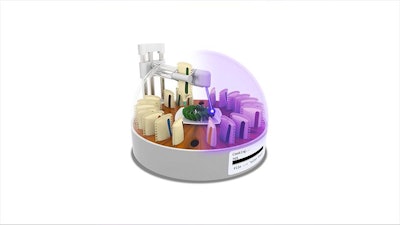
Sci-fi imaginings may soon become reality. Researchers at Columbia University have developed a prototype of a fully autonomous digital chef capable of simultaneously 3D printing chicken and heating the food with lasers.
Sounds like something you’ve seen on “The Jetsons,” right?
The study, published September 1, 2021 in npj Science of Food, explored various modalities of cooking with blue light (445 nm) and infrared light (980 nm and 10.6 μm) on 3D printed chicken. 3D printing uses a precision printer that deposits cells according to detailed computer designs and models to create lab-grown meat. Over the course of several hours, it results in an organic object made up of many thin layers. The layers are held together by a collagen scaffolding.
3D printed chicken cutlets were chosen as a model food system, although the researchers noted that the technology could one day be used to cook full meals at once. Imagine this: prepare chicken breasts, green beans, mashed potatoes, and rolls with a simple push of a button.
The researchers assessed cooking depth, color development, moisture retention and flavor differences between the laser-cooked and stove-cooked meat. The results revealed that the laser-cooked 3D printed chicken has less shrinkage, double the moisture content and similar flavor development to the conventionally cooked meat.
The hardware and software components used for this technology are both low-tech, but high-level software – a Food CAD or food Photoshop – is still needed so that your average consumer can design the foods they want.
Will consumers use it?
I’ll admit that I’m intrigued by the technology, but that shouldn’t be a huge surprise given that my days are filled with exploring what’s coming next.
Simultaneous laser cooking and 3D printing seems like it could fulfill several of the jobs consumers expect food to perform – especially instant add and appliance compatible – so I could see it being of interest to shoppers someday.
However, consumer acceptance of 3D printed and the high cost of the growth medium required to manufacture 3D printed chicken are likely to be limiting factors. In addition, The Counter recently published a story suggesting that many of the predicted benefits of lab-grown meat may be overblown.
What about you? Are interested in an appliance that can 3D print and cook your food? Share your thoughts below.


















